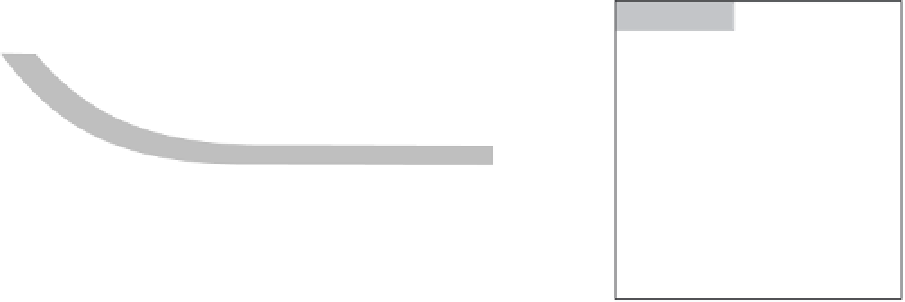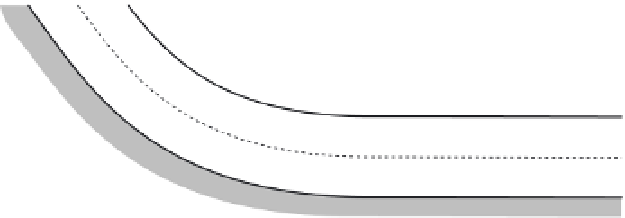Environmental Engineering Reference
In-Depth Information
w
Figure 7.11
Schematic
showing hypothetical aquifer
cross section to illustrate
calculation of groundwater
velocity from Equations (
7.19
)
and (
7. 20
).
w
is width of
recharge area where aquifer is
unconfined;
Z
is thickness of
confined part of aquifer;
x
1
and
x
2
are sampling points; and Δ
x
is
distance between
x
1
and
x
2
.
Water table
Confining layer
x
2
x
1
z
Aquifer
∆
x
Confining layer
the silty sand aquifer at the Sturgeon Falls study
site, Ontario, Canada; Equation (
7. 3
) was used
to estimate recharge. Groundwater ages can be
used to estimate recharge rates in less idealized
systems as well, if the recharge location and
flow pathway for the sampled water are known.
Groundwater flow models are useful tools for
identifying groundwater flow paths and assess-
ing the validity of assumptions on age distribu-
tions and tracer transport in general (Robertson
and Cherry,
1989
; Engesgaard
et al
.,
1996
; Zhu,
2000
; McMahon
et al
.,
2004
).
When mixing of ages is apparent in ground-
water samples, whether due to natural proc-
esses or artifacts of sampling, Equations (
7.16
)
and (
7.17
) are not directly applicable. However,
age-date data can be used in an age mass-bal-
ance approach to estimate average recharge for
the aquifer:
similar to the flow-net analysis described in
Section 6.3.3
, can then be used to relate
v
h
to
v
v
in
the unconfined regions of these aquifers, where
recharge is occurring (Cook and Böhlke,
2000
):
v Z
(7. 20 a)
wv
=
v
h
vZ w
(7. 20b)
v
=
h
/
v
where
w
is width of recharge area and
Z
is
thickness of the confined part of the aquifer.
Equation (
7. 20 a
) simply states that, within a
vertical cross section aligned with flow lines
of the aquifer, the vertical flow of water across
the water table is equal to the horizontal flow
through the aquifer. Inherent to the equation
are assumptions of steady flow and no add-
itional sources or sinks of water movement to or
from the aquifer. Recharge can be calculated by
inserting the value of
v
v
from Equation (
7. 20b
)
into Equation (
7.16
).
RZ
=
ϕτ
.
/
(7.18)
where
τ
is average age or residence time of
water in the aquifer (Böhlke,
2002
). Equation
(
7.18
) is analogous to the chloride mass-balance
Equation (
7.10
). Many of the considerations dis-
cussed for chloride mass-balance methods are
relevant here as well.
Age dates can also be used to estimate hori-
zontal velocity,
v
h
, in a confined aquifer, in
which flow lines are horizontal (
Figure 7.11
):
=
7.3.2 Natural environmental tracers
Chloride
The groundwater chloride mass-balance (CMB)
method is similar to the unsaturated-zone CMB
method described in
Section 7.2.2
; the column
used for derivation of Equations (
7. 8
) to (
7.10
)
now extends to the water table, and in those
equations drainage (
D
) is replaced by recharge
(
R
) and chloride concentration in unsaturated-
zone pore water (
C
uz
) is replaced by chloride con-
centration in groundwater (
C
gw
). Equation (
7.10
)
takes the form:
v
(
Age
−
Age
)/
∆
x
(7.19)
h
1
2
where
Age
i
is apparent groundwater age at point
x
i
along a flow line at the mid distance between
confining layers and Δ
x
is the distance between
points
x
1
and
x
2
. A mass-balance approach,
CP M
+
PC
*
(7. 21)
p
p
app
R
=
=
C
C
gw
gw













